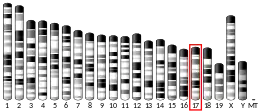Transmembrane protein 151b
Transmembrane protein 151B is a protein that in humans is encoded by the TMEM151B gene.[5]
| TMEM151B | |||||||||||||||||||||||||||||||||||||||||||||||||||
|---|---|---|---|---|---|---|---|---|---|---|---|---|---|---|---|---|---|---|---|---|---|---|---|---|---|---|---|---|---|---|---|---|---|---|---|---|---|---|---|---|---|---|---|---|---|---|---|---|---|---|---|
| Identifiers | |||||||||||||||||||||||||||||||||||||||||||||||||||
| Aliases | TMEM151B, C6orf137, TMEM193, bA444E17.5, transmembrane protein 151B | ||||||||||||||||||||||||||||||||||||||||||||||||||
| External IDs | MGI: 2685169 HomoloGene: 19365 GeneCards: TMEM151B | ||||||||||||||||||||||||||||||||||||||||||||||||||
| |||||||||||||||||||||||||||||||||||||||||||||||||||
| |||||||||||||||||||||||||||||||||||||||||||||||||||
| |||||||||||||||||||||||||||||||||||||||||||||||||||
| |||||||||||||||||||||||||||||||||||||||||||||||||||
| Wikidata | |||||||||||||||||||||||||||||||||||||||||||||||||||
| |||||||||||||||||||||||||||||||||||||||||||||||||||
Nomenclature
The Transmembrane protein 151B gene is also known as TMEM151B, C6orf137, and bA444E17.5.[6]
Gene
The gene is located on the positive strand of chromosome 6 at the location 6p21.1 from the chromosome position 44270450 to 44279444, for a total length of 8,995 base pairs.[7] It is a complex locus that contains both TMEM151B and SPATS1.[8] TMEM151B has one paralog: TMEM151A.[9]
Transcript
The mRNA contains 3 exons, with a transcribed mRNA length of 4911bp, and the coding region containing 1701bp.[7]
Protein
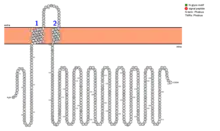
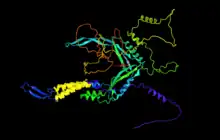
The protein has a length of 566 amino acids and contains two transmembrane domains.[6] According to Compute pI/Mw, molecular weight of approximately 61 kDa, which matches the weight listed on NCBI, and a theoretical isoelectric point of 6.72.[11][6] The human TMEM151B protein composition is poor in lysine and arginine, lysine comprising 1.4% of the amino acids and arginine making up 0.8% of the total protein. The mouse ortholog is also arginine poor.[12]
Expression

RNA-seq gene expression profiling shows high expression in the brain, and notable expression in the testes.[14] NCBI geo profiles similarly show localization to the brain tissues.[15] Within the mouse brain, TMEM151B has high expression particularly within the cerebellum, medulla, and olfactory bulb according to the Allen Brain Atlas.[13]
Homology and evolution

The TMEM151B gene is conserved within most vertebrates, and appears to be conserved within some invertebrates. Its paralog, TMEM151A, has a 47.7% sequence identity with TMEM151B.[9][18] The evolution rate is relatively slow: between the rate of change in fibrinogen alpha and cytochrome c.[9][19]
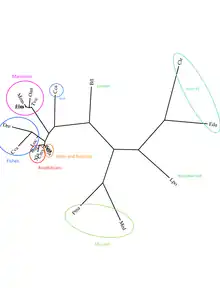
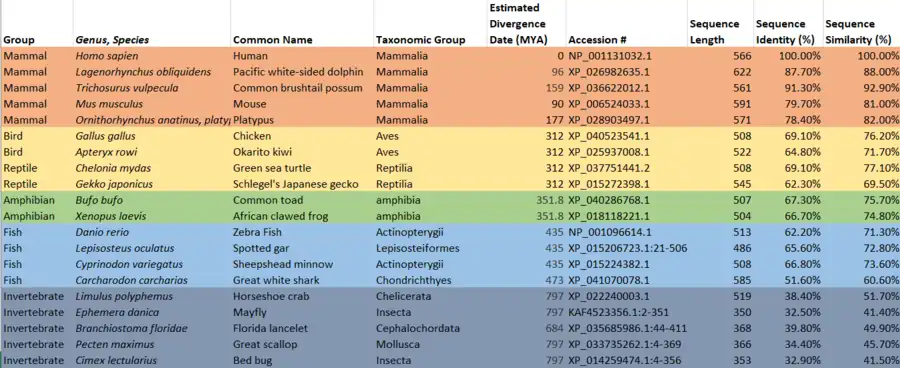
Research
Alternative splicing of TMEM151B along with 4 other genes were linked to colorectal cancer.[20] It was also found to be up-regulated in post-menopausal breast cancer.[21][22] A SNP found within TMEM151B is associated with the development of lean muscle.[23]
References
- GRCh38: Ensembl release 89: ENSG00000178233 - Ensembl, May 2017
- GRCm38: Ensembl release 89: ENSMUSG00000096847 - Ensembl, May 2017
- "Human PubMed Reference:". National Center for Biotechnology Information, U.S. National Library of Medicine.
- "Mouse PubMed Reference:". National Center for Biotechnology Information, U.S. National Library of Medicine.
- "Entrez Gene: Transmembrane protein 151B".
- "transmembrane protein 151B [Homo sapiens] - Protein - NCBI". www.ncbi.nlm.nih.gov. Retrieved 2021-09-29.
- "Homo sapiens transmembrane protein 151B (TMEM151B), mRNA - NCBI". www.ncbi.nlm.nih.gov. Retrieved 2021-09-29.
- "AceView: Gene:TMEM151BandSPATS1, a comprehensive annotation of human, mouse and worm genes with mRNAs or ESTsAceView". www.ncbi.nlm.nih.gov. Retrieved 2021-10-04.
- "BLAST: Basic Local Alignment Search Tool". blast.ncbi.nlm.nih.gov. Retrieved 2022-01-13.
- "Protter - interactive protein feature visualization". wlab.ethz.ch. Retrieved 2022-01-13.
- "ExPASy - Compute pI/Mw tool". web.expasy.org. Retrieved 2022-01-13.
- "SAPS < Sequence Statistics < EMBL-EBI". www.ebi.ac.uk. Retrieved 2022-01-13.
- "ISH Data :: Allen Brain Atlas: Mouse Brain". mouse.brain-map.org. Retrieved 2022-01-13.
- "TMEM151B transmembrane protein 151B [Homo sapiens (human)] - Gene - NCBI". www.ncbi.nlm.nih.gov. Retrieved 2022-01-13.
- "GDS596 / 213678_at". www.ncbi.nlm.nih.gov. Retrieved 2022-01-13.
- "TMEM151B (RP11-444E17.5) Result Summary | BioGRID". thebiogrid.org. Retrieved 2022-01-13.
- "SREBF2 Gene - GeneCards | SRBP2 Protein | SRBP2 Antibody". www.genecards.org. Retrieved 2022-01-13.
- "Clustal Omega < Multiple Sequence Alignment < EMBL-EBI". www.ebi.ac.uk. Retrieved 2022-01-13.
- "TimeTree :: The Timescale of Life". www.timetree.org. Retrieved 2022-01-13.
- Liu J, Li H, Shen S, Sun L, Yuan Y, Xing C (2018). "Alternative splicing events implicated in carcinogenesis and prognosis of colorectal cancer". Journal of Cancer. 9 (10): 1754–1764. doi:10.7150/jca.24569. PMC 5968763. PMID 29805701.
- Carter JM, Nair AA, Davila JI, Heinzen EP, Hoskin TL, Winham SJ, et al. (2019-02-15). "Abstract P3-08-10: A unique coding and non-coding benign breast transcriptome in post-menopausal ER+ breast cancer". Poster Session Abstracts. American Association for Cancer Research. 79 (4_Supplement). doi:10.1158/1538-7445.sabcs18-p3-08-10. S2CID 164377723.
- Qian D, Zheng Q, Wu D, Ye B, Qian Y, Zhou T, et al. (2021-05-13). "Integrated Analysis of ceRNA Network Reveals Prognostic and Metastasis Associated Biomarkers in Breast Cancer". Frontiers in Oncology. 11: 670138. doi:10.3389/fonc.2021.670138. PMC 8158160. PMID 34055638.
- Pei YF, Hu WZ, Yang XL, Wei XT, Feng GJ, Zhang H, et al. (November 2019). "Two functional variants at 6p21.1 were associated with lean mass". Skeletal Muscle. 9 (1): 28. doi:10.1186/s13395-019-0212-3. PMC 6874818. PMID 31757224.
Further reading


